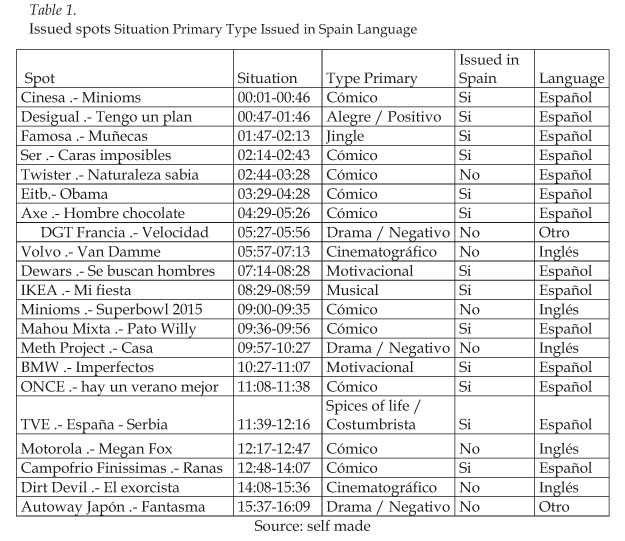
doi.org/10.15178/va.2017.141.39-54
RESEARCH
GENDER DIFFERENCES IN AUDIOVISUAL CONSUMPTION: A NEUROSCIENCE EXPERIMENT ON TV ADS
DIFERENCIAS DE GÉNERO EN EL CONSUMO AUDIOVISUAL: UN EXPERIMENTO DE NEUROCIENCIA SOBRE SPOTS DE TELEVISIÓN
DIFERENÇAS DE GENÊRO NO CONSUMO AUDIOVISUAL: UM EXPERIMENTO DE NEUROCIÊNCIA SOBRE SPOTS DE TELEVISÃO
Alejandro Tapia-Frade1 has a degree in Advertising and Public Relations (1999) and a PhD in Marketing (2005), both from the Complutense University of Madrid. He has the ANECA and ACSUCYL accreditations of Associate Professor. In addition, he has a six-year period of research granted by ACSUCYL. He is an Adjunct Professor at Loyola University of Andalusia. https://www.researchgate.net/profile/Alejandro_Tapia_Frade
Mario Rajas-Fernández2 Mario Rajas Fernández holds a degree and a PhD in Audiovisual Communication from the Complutense University of Madrid. He is a Contracted Doctor Professor at Rey Juan Carlos University of Madrid. In addition, he has a six-year period of research granted by CNEAI. https://orcid.org/0000-0002-3807-8327
Elena Martín-Guerra3 Elena Martín Guerra has a degree in Advertising and Public Relations from Miguel de Cervantes European University and a degree in Journalism from the University of Valladolid. She is currently a PhD student at the Faculty of Information Sciences of the Complutense University of Madrid. In addition, she is the CEO of Sociograph Neuromarketing, a communications and Neuroscience consulting firm. https://scholar.google.es/citations?user=9sO-s-MAAAAJ&hl=es
1Loyola University Andalusia. Spain
2Rey Juan Carlos University. Spain
3Complutense University of Madrid. Spain
ABSTRACT
This paper shows the results of an experiment in neuroscience on a group of 20 people applied to audiovisual consumption, particularly television spots. The method used was the measurement and analysis of their electrodermal activity. The results indicate significant differences in attention by gender. The most notable increases seem to be more related to the sound than to the picture. The comic theme aroused a higher level in men but not in women. Similarly, the novelty seems to be an important factor in generating attention and excitement, as the spots not issued in Spain had significantly higher values on attention and emotion. Finally, the spots where the language of speech was not Spanish also had significantly higher values in attention, but not in emotion.
KEYWORDS: Neuroscience, advertising, spot, attention, emotion, gender, electrodermal
RESUMEN
Este trabajo presenta los resultados de un experimento de neurociencia sobre un grupo de 20 personas aplicado al consumo audiovisual, en concreto spots de televisión. El método usado fue la medición y análisis de su actividad electrodérmica. Los resultados indican diferencias significativas en atención según género, y cuyos incrementos más notorios parecen estar más relacionados con el sonido que con la imagen. La temática cómica despertó mayor nivel en los hombres, pero no en las mujeres. De igual modo, la novedad parece un factor relevante en la generación de atención y emoción, ya que los spots no emitidos en España obtuvieron valores significativamente superiores en atención y emoción. Finalmente, los spots cuyo idioma de locución no era el español también obtuvieron valores significativamente superiores en atención, pero no en emoción.
PALABRAS CLAVE: Neurociencia, publicidad, spot, atención, emoción, género, actividad electrodérmica
RESUMO
Este trabalho apresenta os resultados de um experimento de neurociência sobre um grupo de 20 pessoas aplicado ao consumo audiovisual, em concreto, spots de televisão. O método usado foi a medição e analises de sua atividade eletro dérmico. Os resultados indicam diferenças significativas em atenção segundo o gênero e cujos incrementos mais notórios aparecem estar mais relacionados com o som que com a imagem. A temática cômica despertou maior nível nos homens, mas não nas mulheres. Igualmente, a novidade parece um fator relevante na geração de atenção e emoção, já que os spots não emitidos na Espanha obtiveram valores significativamente superiores na atenção e emoção. Finalmente, os spots cujo idioma de locução não era o espanhol, também obtiveram valores superiores na atenção, mas não em emoção.
PALAVRAS CHAVE: Neurociência , Publicidade, Spot, Atenção, Emoção, Gênero, Atividade Eletro dérmico
Received: 18/02/2017
Accepted: 30/03/2017
Published: 15/12/2017
Correspondence: Alejandro Tapia Frade. ajtapia@uloyola.es
Mario Rajas Fernández. mario.rajas@urjc.es
Elena Martín Guerra. emartin@sociograph.es
How to cite this article
Tapia Frade, A., Rajas Fernández M., Martín Guerra, E. (2017). Gender differences in audiovisual consumption: a neuroscience experiment on tv ads [Diferencias de género en el consumo audiovisual: un experimento de neurociencia sobre spots de televisión]
Vivat Academia. Revista de Comunicación, 141, 39-54
doi http://doi.org/10.15178/va.2017.141.39-54
Recuperado de http://www.vivatacademia.net/index.php/vivat/article/view/1033
1. INTRODUCTION
The media are very interested in knowing in depth how their contents are consumed and who their consumers are, since the audience they generate is responsible, to a certain extent, for one of their main financing channels, advertising.
In that sense, in a global way, it has been pointed out that both men and women seek entertainment on television, they like characters from comic series, which are usually mature and fiction men (Medrano, 2014, p. 3).
However, the same study points out some differences by age groups. Thus, adolescents opt for programs of positive content and humor, characters from comic series and cartoons, which may be children or adolescents and who do not pursue a specific profession.
In this context, young people incline towards evasion programs and adults, in addition to said programs, toward competitions and information, and both value the professionalism of the chosen characters, who are usually adults or seniors (Medrano et al. ., 2014, p. 1).
Therefore, it is fundamental not only to come to know the number of viewers who are watching a program but also to know as deeply as possible the way in which their programs are consumed, and by whom they are consumed to a greater extent. Even more, it is undoubtedly interesting to know the way in which commercial performance is consumed, the television spots, since, with this knowledge, the way to increase the efficiency of said action will be observed, which will return more benefits also to the media.
However, the psyche of the audience is a phenomenon of extraordinary complexity. In this context, the subjective or opinion measuring systems, such as the survey, can be insufficient when the fact to investigate contains irrational, sentimental elements or elements that are difficult to identify by the investigated subjects. In these cases, the use of objective, psychobiological systems can be very helpful.
At present, the most commonly used psychobiological methods are positron emission tomography, functional magnetic resonance imaging, electroencephalography, magnetoencephalography and electrodermal activity (Touhami et al, 2011, p. 1528). The importance of these studies is growing since a few years before, despite its novelty - the term neuromarketing emerged in 2002- (Morin, 2011, p. 131, Blakeslee, S. 2004), and it is often applied to marketing studies (Gil-La Fuente, Vidal and Martínez, 2010, Muñoz Sánchez, 2012, Burgos-Campero and Vargas-Hernández, 2013, Dapkevicius and Melnikas , 2009, Fugate, 2007, Avendaño Castro, 2013).
The electrodermal activity (EDA) is widely used in social science research, due to its high capacity to respond to new, affective, threatening and cognitive stimuli, as well as anxiety-and-stress-arousing situations (Beer, 2007, pp. 69-86). It can be classified into three categories (Martínez Herrador, JL, Monge Benito, S. and Valdunquillo Carlón, MI, 2012):
a) First, the tonic activity -EDL- (electrodermal level) that would indicate basal levels of activation with involvement in the attention processes. High values of EDL would indicate higher activation-attention levels.
b) Secondly, the phasic activity -EDR- (electrodermal response) means specific psychophysiological responses that refer to the rapid changes in conductivity. To Martinez Herrador (2012), it is a good predictor of change after exposure to a stimulus and therefore is considered valid in this study.
c) Third, spontaneous activity -NSA- (non-specific activity) refers to that non-specific psychophysiological activity that cannot be attributed to a known trigger, since its presentation is not controlled. These are situational responses that represent the index or degree of activation of the subject, so that the higher the NSA, the more spontaneous the activity of the subject. It can be considered as “noise” in the records (Nikula, 2007: 86-90; Herrador Martínez, JL, Monge Benito, S. and Valdunquillo Carlón, MI, 2012: 56).
This article shows the results of a neuroscience experiment through the objective and simultaneous analysis of the behavior, in terms of attention and emotion, of a group of 25 people when watching a battery of television spots, the electrodermal activity of said group of people being analyzed.
2. OBJECTIVES
The objectives proposed for this test are:
1) Analysis of the difference of the signals associated with attention (EDL) and emotion (EDR) according to the typology of the spot.
2) Analysis of the difference of the aforementioned signals as regards gender.
3. METHODOLOGY
The measuring instrument analyzes the electrodermal activity in three types of signals (Martínez Herrador, JL, Monge Benito, S. and Valdunquillo Carlón, MI, 2012):
1) The tonic activity related to attention (EDL, or electrodermal level). The unit of measurement used is the sum of electrodermal resistance in kiloohms (KΩ) of all participants. It is important to point out that the lower the resistance, the higher the level of attention.
2) The phasic activity, related to emotion (EDR or electrodermal response). In this case, the unit of measurement is the arithmetic mean of electrodermal resistance in kiloohms (KΩ) of all participants. In this case, the higher the average, the greater the intensity of emotion. It should be noted that the machine simply detects the presence of emotion, but not its type or content, thus not discriminating between positive and negative emotions.
3) A spontaneous, non-specific, random and independent signal of each person (NSA, or non-specific activity). The unit of measurement used is the electrodermal resistance in kiloohms (KΩ). This signal, because it is nonspecific and subjective, should be considered noise, for which reason it was compensated by means of the global arithmetic mean, in order to subsequently discriminate and disregard it.
This technology, named Sociograph, patent no. 9902767, has been used in previous cases such as Martínez Herrador, JL et al. (2008, 2012) and Aiger, M. et al. (2013).
The sampling method was chosen for convenience, and consists of 25 people aged 20 to 30 years in similar proportion as regards sex. Therefore, the results have an exploratory character.
The spots broadcast are shown in the following table.

The spots were classified according to a typology in two steps, so that the primary type reflects the essential aspect of the spot and the secondary one qualifies this essential primary type. Specifically, the possibilities that were listed for both types were musical, jingle, comic, dramatic / negative, motivational, joyful / positive, cinematographic, spices of life / local-customs-related and landscape / precious characters.
The brand responsible for the spot was also highlighted and if the spot was broadcast in Spain and in what year, which can be related to the a priori familiarity developed with the brand and the spot.
Finally, the language of the spot locution is also indicated (Spanish, English, another and without locution), since it could have an impact on understanding the spot and this could impinge on the attention deployed to understand it and the emotional intensity developed.
A pass of 25 people was held on March 23, 2015 in the room of degrees of Miguel de Cervantes European University, in Valladolid. At the entrance to the premises, a bracelet was placed on the participants, who sent the information about each person to a central processing unit in charge of the necessary calculations and of storing them.
For the analysis of the collected data, statistical techniques appropriate to the characteristics of the obtained time series were used, making use of models for longitudinal studies.
4. RESULTS
4.1. Attention
The average level of attention is 281.300 KΩ (280.996 KΩ in the case of men and 273.598 KΩ in the case of women), with an average standard deviation of 8.3955 KΩ (11,793 K for men, and greater for women, 18,920 KΩ).
The coequalities of kurtosis (0.745) and Fisher’s asymmetry (0.351) for the whole sample assume a leptokurtic-type distribution with slight asymmetry to the right (positive asymmetry). In the case of men, the coefficients of kurtosis (0.027) and asymmetry (0.475) indicate a slightly leptokutric distribution with asymmetry to the right (positive asymmetry), while the same coefficients in the case of women (0.044 for kurtosis and - 1,176 for asymmetry) indicate a similar degree of pointing but a different asymmetry (in this case the asymmetry is left or negative).
It should be noted, before presenting the results in detail, that the level of attention is measured in terms of resistance, so the greater the resistance, the less the attention, and vice versa.
Thus, in the broadcast spots, a valley structure with a certain level of initial decrease (more pronounced in the case of women) up to approximately 5:30 minutes, and a more or less constant level of attention later, can be seen in general terms.
However, the analysis of the attention curve should be based on the estimation of the tonic level change rates (EDL), which can be seen in Picture 1. In this case, an increase in the level of EDL implies an increase in attention and its decrease means a decrease. Therefore, the most relevant feature of the series is the growth or decrease and its intensity throughout the session.
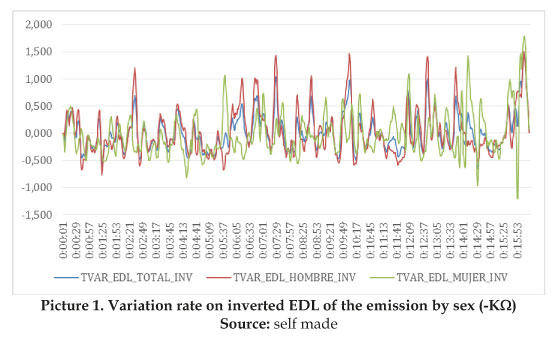
Thus, the peaks represent moments of substantive attention increase, therefore representing moments in which a stimulus suddenly arouses the attention of the spectators. The content of these moments in the broadcast is summarized below.
1) Ser.- Impossible faces (2:29 a 2:35). Men (EDL exchange rate: 7.1173 ΔKW). In sound, one listens to the song “you are very ugly, but very very ugly, you have nothing I can fall in love with”. In visual, close-ups of faces of men on camera in slow motion.
2) DGT .- France (5:38 to 5:45). Women (6.9186). In sound, the voice of a woman and a child after an accident is heard. In visual, one sees a car overturned after an accident. A man gets out of the car.
3) Volvo .- Van Damme (6:14 to 6:20). Men (6.0804). In sound, the voice of Van Damme in English is heard speaking about the qualities of the truck and its body, and in the background an epic-type sound, in particular the beginning of the song. In visual, the beginning is a close-up of Van Damme, opening up to a general shot in which the protagonist is seen on the rear-view mirrors of two golden trucks.
4) Dewars .- Men are sought (7:24 to 7:32). Men (9,6084). In sound, one can see the address of a man who says “long waits without immediate reward. Essential companionship”. In visual, one sees a set of clouds, a fade and a mountain with vegetation. Subsequently, a close-up of a man with a boat, and then a wooden barrel that is turned.
5) Ikea .- My party (8:40 to 8:45). Men (5,1818). In sound, it begins with a song that says “I have the right to my party, I have the right to my party”. The accompanying sound instrument is an electric guitar. In visual, a lass jumps with a raised hand, then a close-up of a lass whose hair is ruffled, an average shot of three women on a terrace, an elderly couple cooking and two men jumping. All in slow motion.
6) Meth Project .- House (9:57 to 10:06). Men (11,383). In sound, the gate of a garden sounds, a dog and someone knocking on a door. In visual, a young man opens a gate quickly, violently, and goes to a door that he hits. There is also a hall, and two elderly people. The man embraces the woman and turns off the light.
7) TVE. Spain - Serbia (12:04 to 12:09). Women (5,674). In sound, a strident sampling begins. In visual, a man in his pajamas climbs a staircase while a Serbian dressed in a football garment watches him at the foot of the staircase. The phrase “The Serbs do not scare us” is superimposed
8) Motorola .- Megan Fox (12:42 to 12:49). Men (8,981). End of the spot. In sound, Megan Fox is seen saying “probably nothing”. In visual, one sees Megan Fox in a general shot in a bathtub, and then a cell phone and, over impressed, the Motorola logo.
9) Campofrío Finissimas Frog (13:43 to 13:48). Men (5.9404). In sound, “take advantage of this. Finissimas de Campofrío. Now with a reclosable pack” is spoken. In visual, a man in an office stands up and, with his hands raised, says what is indicated. Then there is a blister with the product, and a hand that opens it.
10) Dirt Devil.- The Exorcist (14:08 to 14:17). Women (10,176). The spot starts. In sound, one can see how a door opens squeakily, and then a sonorous atmosphere of suspense. In visual, what looks like a clergyman opens a door, climbs a staircase in a dark and suspenseful environment.
11) Autoway Japan.- Ghost (15:58 to 16:15). Men (17,627). Women (24,041). In sound, a very strong blow on a car glass precedes screaming. In visual, what looks like a ghost of a lass with a distorted face hits the glass of a car very violently. Subsequently, the car backs away amid the shouts of the occupants.
The previously presented cases having been analyzed, a common sound initiator can be suggested, which, in the case of women, could be related to an important change in range in sound. In the case of men, said sound initiator seems to be more related to a change in voice range.
In relation to the visual, atypical situations arise in content or form, or situations of special beauty. They are definitely visual moments that break with what is usual.
However, and in addition to specific moments in which the attention is suddenly increased, it is interesting to consider which announcements have a general balance of positive EDL and therefore are spots that attract attention, and which have a negative balance, resulting in spots that diminish attention or distract.
The results are shown in Table 2, and the EDL balance sheet of the spot.
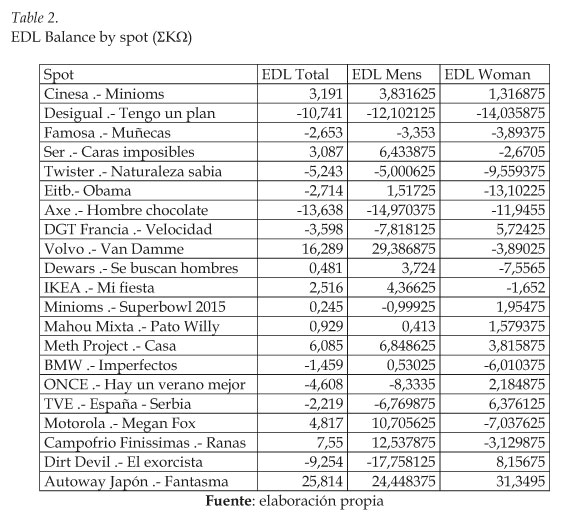
The spot of Autoway Japan stands out as the spot in global terms to which more attention has been paid. This is definitely a spot to which much attention is paid as it is particularly shocking. So much so that this announcement has been named by many blogs and specialized publications as “the most terrifying spot in the world” (RRPP Noticias, 2013, Reason Why, 2013, infotaller.tv, 2013, El Comercio, 2013).
A spot to which men have also paid much attention is that of the Volvo brand, starring Van Damme and set to music by Enya. Other spots that have worked in terms of EDL in men but not in women have been those of Cadena Ser (impossible faces), Motorola (starring Megan Fox), Campofrío Finissimas (frogs) and, to a lesser extent, Ikea (my party).
On the contrary, the spots that have captured the attention of women but not of men have been those of Dirt Devil (the exorcist) and DGT Francesa (Speed) and, to a lesser extent, those who had the Minioms as protagonists (Cinesa and Superbowl). 2015) and ONCE (there is a better summer).
4.2. Emotion
The average level of emotion obtained by the series was 0.1229 KΩ, with an average standard deviation of 0.1161 KΩ (average of 0.1400 and standard deviation of 0.1402 in the case of men, and values of 0.1506 and 0.221 respectively for women).
No significant differences in mean emotion were obtained in relation to sex (p ≤ 0.214, t value, -1.243 and gl 1628.846, not assuming equal variances, Levene test p ≤ 0.011 and F value 6.425).
In this case, the coefficients of kurtosis (16,738) and asymmetry (3,328) indicate a leptokurtic distribution, much more pronounced for women (62.034) than for men (6,741) with a positive asymmetry or to the right (3,328), also more pronounced in the case of women (6,459) than of men (2,434).
The analysis of the EDR level in the subsequent time series shows sudden changes in the resistivity of the skin that are related to reactions to specific stimuli. Those areas where change is high indicate greater emotional response, whereas those areas without significant changes are considered poorly exciting. The following picture indicates the EDR levels obtained in the session.
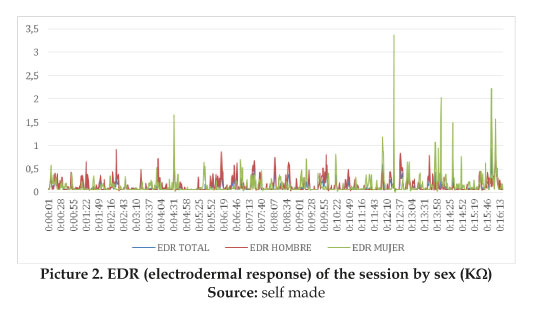
Examining the series, emotional intensity is detected in moments 4:32, 12:22, 14:07, 14:34, 15:55 and 16:03. The content of such moments is shown later.
1) 4:32, Woman (1,649 KΩ). Ax Spot .- Man Chocolate. A man with a naked torso applies a deodorant
2) 12:22, Woman (3,373). Spot of Motorola .- Megan Fox. Megan Fox holds a cell phone when she talks about social network management.
3) 14:07, Woman (2,027). Spot of Dirt Devil.- The exorcist. Start of the spot. After a black farm, a blow sounds and a person who enters a house is seen. The atmosphere is suspense.
4) 14:34, Woman (1,491). Spot of Dirt Devil.- The exorcist. There are several shouts. A man, with the appearance of a cleric, and a woman are at the door of a room.
5) 3:55 PM, Woman (2,218) Spont of Autoway Japan.- Ghost. A ghost hits the glass of a vehicle. The blow on the glass sounds
6) 16:03, Man (2,385), Spot of Autoway Japan.- Ghost. Shouts from the occupants of a vehicle are heard while the vehicle is going backwards.
The correlation analysis could not show an objective relationship between EDR peaks and EDL stretches.
On the other hand, it is interesting to note that four out of the six moments of greatest EDR intensity occur in situations where suspense or fear prevails.
In addition to the sudden generation of intense emotional peaks, it is also interesting to evaluate the amount of EDR generated on average per every spot. The results can be seen in the following table.
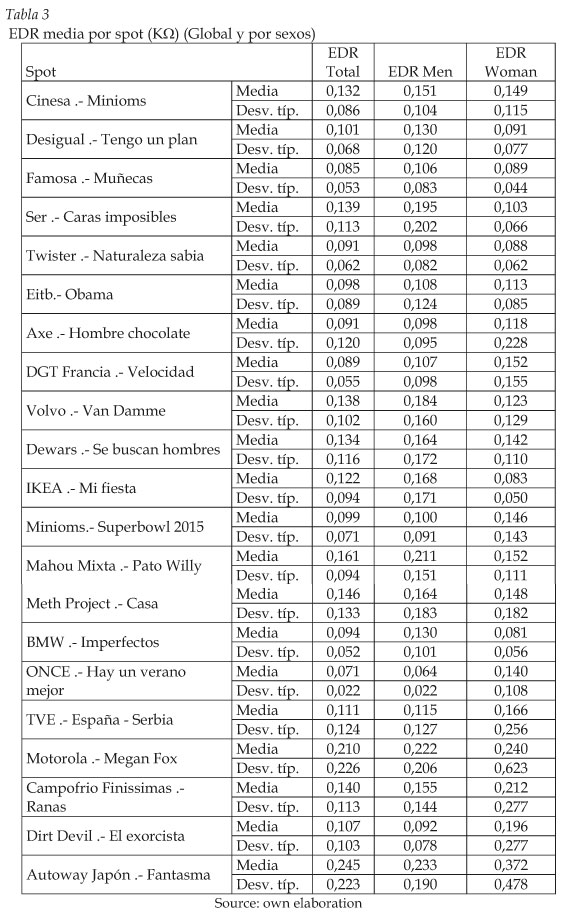
Thus, the five more exciting spots in general terms are those corresponding to the brands Autoway Japan, Motorola, Mixed Mahou, Campofrío Finissimas and Cadena Ser. However, this classification varies by sex. Thus, in the case of women, the ranking of the five brands with the highest average EDR are Autoway Japan, Motorola, Campofrío Finissimas, Dirt Devil and TVE. In the case of men, the first two places coincide (Autoway Japan and Motorola), and then Cadena Ser and Volvo.
It is also worth noting that all the spots in the mentioned EDR rankings are spots with positive EDL, that is, spots that attract attention.
It could also be proved that the spots that had not been issued in Spain and, therefore, were unfamiliar a priori to the audience were significantly more attended and generated greater emotional intensity than those who were issued in Spain (p ≤ 0.000, t value 5,609, and gl 666,094, not assuming equal variances, Levene’s test p ≤ 0,000 and F value 20,613 for average value in total EDL exchange rate, and p ≤ 0.008, value t 2,664, and gl 629,510, not assuming equal variances, Levene’s test p ≤ 0.000 and F value 19,630 for mean value in total EDR).
Regarding the language, significant differences were found in attention (the more distant a priori language, the more attention to the spot) but not in emotional intensity by means of ANOVA test (p ≤ 0,000, 0,003 and 0,004 of the language neither Spanish nor English with respect to them).
Concerning the primary types of spot, it should be noted that the drama / negative type obtained significantly higher averages than the other types except for the musical in an average exchange rate in attention (EDL), and all except the aforementioned musical and local-customs-related type in emotional intensity (EDR), largely caused by the contribution of the spot of Autoway Japan.
5. DISCUSSION
It should be noted first that the test shows a valley structure in which attention decreases up to minute 5.30 to gently increase the rest of the session.
On the other hand, although women also had an average emotional level higher than that of men, no significant difference could be concluded in this regard.
Sudden increases in attention seem to be more related to sound than to the image. Thus, it could be observed that the attention of the sample rose suddenly when there was an intense change in the sound record.
The comic theme aroused greater attention in the case of men, but not in the case of women, who do not have a remarkable theme about the rest.
In the case of emotion, it is noteworthy that four out of the six major emotional peaks occurred in situations of suspense or terror.
It was not possible to contrast the objective relationship between increased attention spans (EDL) and emotion peaks (EDR).
Novelty seems to be a relevant factor in the generation of attention and emotion. Thus, the spots not issued in Spain obtained values of attention and emotion significantly higher than those issued in Spain. Regarding the broadcasting language, it is also noteworthy that the spots with a language other than Spanish obtained values significantly higher than those issued in Spanish as regards attention (EDL), but not concerning emotion (EDR).
The major limitations of this study are related to the limited sample size, although recent studies indicate that the sample size for a study of these characteristics is adequate (Karmarkar, 2015; Orzan, 2015; Vecchiato, 2014; Martínez Herrador, 2012; Reimann, 2012).
The implications of this piece of research for the improvement of efficiency in television advertising communication are clear, since it provides relevant information for the realization of effective advertising spots. In addition, it could be significant, considering the high cost of broadcasting these advertising spots on television.
On the other hand, it would undoubtedly be interesting to delve into the content of the emotional response to the spot, given that this piece of research only highlights the increases and decreases in phasic or emotional activity in the sample, but not its content or its positive or negative evaluation.
REFERENCES
1. Aiger M, Palacín M, Cornejo JM (2013). La señal electrodérmica mediante Sociograph: metodología para medir la actividad grupal. Revista Internacional de Psicología Social: International Journal of Social Psichology, 28(3):333-347.
2. Avendaño-Castro W (2013). Un caso práctico para el análisis del neuromarketing visual en el centro comercial Ventura Plaza (Cúcuta, Colombia). Cuadernos de la administración, 29(49):17-27.
3. Beer J, Lombardo M (2007). Insights into Emotion Regulation from Neuropsychology. En J. Gross, J. Handbook of Emotion Regulation (pp. 69-86). New York: Guilford Press.
4. Blakeslee S (2004). If You Have a ‘Buy Button’ in Your Brain, What Pushes It? New York Times, 19 de Octubre.
5. Burgos-Campero A, Vargas-Hernández J (2013). Analitical approach to neuromarketing as a business strategy Procedia - Social and Behavioral Sciences 99, 517-525. http://dx.doi.org/10.1016/j.sbspro.2013.10.521.
6. Dapkevicius A, Melnikas B (2009). Influence of Price and quality to customer satisfaction: neuromarketing approach. Vilniaus Gedimino technikos universitetas, 3, 17-20. http://dx.doi.org/10.3846/144.
7. El Comercio (2013). ¿Te asusta? Este es el comercial de TV que aterroriza a Japón. Recuperado de: http://elcomercio.pe/mundo/actualidad/este-comercial-llantas-que-aterroriza-japon-ti-video-noticia-1668371.
8. El Hombre Anuncio (2013). Autoway y el anuncio más terrorífico del mundo. Recuperado de: http://www.elhombreanuncio.com/autoway-y-el-anuncio-mas-terrorifico-del-mundo/
9. Fugate D (2007). Neuromarketing: a layman’s look at neuroscience and its potential application to marketing practice. Journal of Consumer Marketing, 24(7):385–394. http://dx.doi.org/10.1108/07363760710834807.
10. Gil-Lafuente J, Vidal JM, Aymerich-Martínez J (2010). The optimization of investment in POS advertising through a fuzzy model based on the application of neuromarketing techniques. Computational Inteligence in Business and Economics, 3, 431-441. http://dx.doi.org/10.1142/9789814324441_0052.
11. Infotaller.tv (2013). Un spot de neumáticos de invierno aterroriza internet. Recuperado de: http://www.infotaller.tv/neumaticos/actualidad/un-spot-de-neumaticos-de-invierno-aterroriza-internet.
12. Karmarkar U, Yoon C, Plassmann H (2015). Marketers should pay attention to fMRI. Harvard Business Review. Recuperado de http://goo.gl/5tDXbJ.
13. Martínez-Herrador JL, Garrido-Martín E, Valdunquillo-Carlón MI, Macava-Sánchez J (2008). Análisis de la atención y la emoción en el discurso político a partir de un nuevo sistema de registro psicofisiológico y su aplicación a las ciencias políticas. DPSA. Documentos de trabajo del Departamento de Psicología Social y Antropología, 2.
14. Martínez-Herrador JL, Monge-Benito S, Valdunquillo-Carlón MI (2012). Medición de las respuestas psicofisiológicas grupales para apoyar el análisis de discursos políticos. Trípodos, 29, 53-72.
15. Medrano-Samaniego C (2010). Los programas y características de los personajes preferidos en el visionado de la televisión: diferencias evolutivas y de sexo. Cultura y Educación, 22(1):3-20. http://dx.doi.org/10.1174/113564010790935196.
16. Morin C (2011). Neuromarketing: The New Science of Consumer Behavior. Symposium: Consumer culture in global perspective, 131-135. http://dx.doi.org/10.1007/s12115-010-9408-1.
17. Muñoz-Sánchez O (2012). La emoción y la razón en la estructura del pensamiento estratégico publicitario. Una visión de la marca desde la psicología cognitiva y la neurociencia. Tripodos, 29, 39-52.
18. Nikula R (2007) Psychological Correlates of Nonspecific Skin Conductance Response. Psichophysiology. 28(1):86-90. http://dx.doi.org/10.1111/j.1469-8986.1991.tb03392.x.
19. Orzan G, Zara I, Purcarea VL (2015). Neuromarketing techniques in pharmaceutical drugs advertising. A discussion and agenda for future research. Journal of medicine and life, 5(4):428-432.
20. Reason Why (2013). El spot de terror japonés que arrasa en todo el mundo. Recuperado de http://www.reasonwhy.es/actualidad/campanas/el-spot-de-terror japones-que-arrasa-en-todo-el-mundo_2013-12-04.
21. Reimann M, Castano R, Zaichkowsky J, Bechara A (2012). Novel versus familiar brands: an analysis of neurophysiology, response latency and choice. Marketing letters, 23(3):745-759. doi:http://dx.doi.org/10.1007/s11002-012-9176-3.
22. RRPP Noticias (2013). Japoneses aterrorizados con spot no apto para cardiacos. Recuperado de http://www.rpp.com.pe/2013-12-04-japoneses-aterrorizados-con-spot-no-apto-para-cardiacos-noticia_652522.html.
23. Touhami ZO, Benlafkin L, Jiddane M, Cherrah Y, El-Malki H, Benomar A (2011). Neuromarketing: Where marketing and neuroscience meet African Journal of Business Management, 5(5):1528-1532. http://dx.doi.org/10.5897/AJBM10.729.
24. Vecchiato G, Cherubino P, Maglione AG, Ezquierro MTH, Marinozzi F, Bini F, Trettel A, Babiloni F (2014). Neurophysiological tools to investigate consumer´s gender differences during the observation of TV commercials. Computational and mathematical methods in medicine, 91, 29-81. doi:http://dx.doi.org/10.1155/2014/912981.